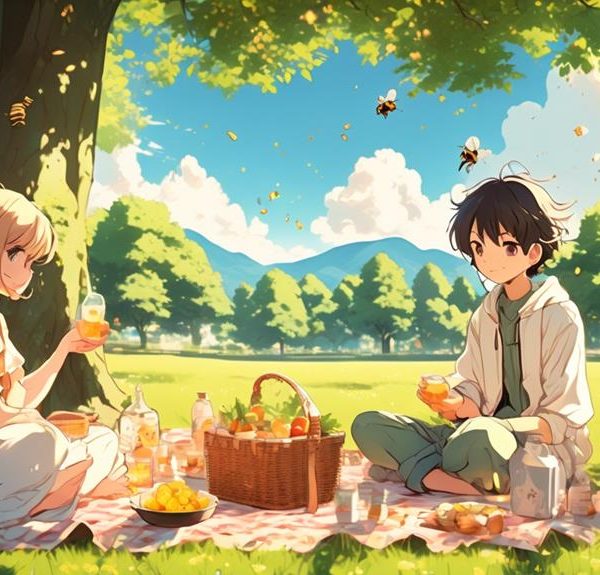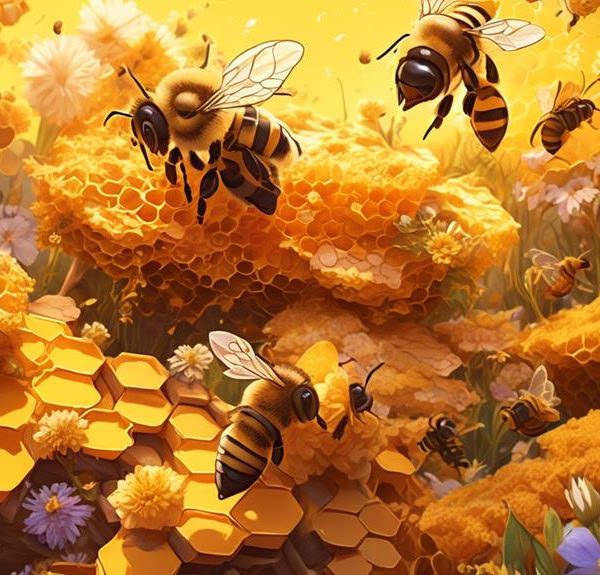Learn about the incredible endurance of bees and their survival strategies when food is scarce.
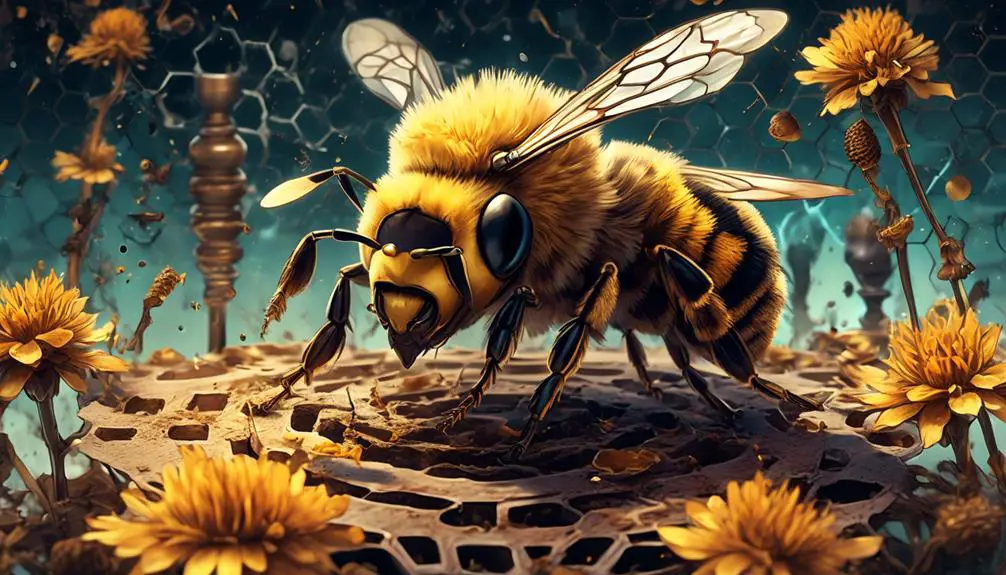
How Long Can Bees Last Without Food?
Imagine you're a long-distance runner. You've trained hard, stocked up on carbs, and hydrated well. You're confident you can run for hours without needing to stop for food or water.
Now, consider a bee – a tiny creature with an equally impressive endurance. How long, you might wonder, can these industrious insects last without food?
You might be surprised to learn that bees, like marathon runners, have their own survival strategies when food is scarce. Let's explore this fascinating topic further, shall we?
Key Takeaways
- Bees' ability to survive without food varies depending on the species and their role in the colony. Honeybees can survive for up to a week due to their nectar storage, while bumblebees can only last a few hours without food.
- Food scarcity directly impacts bee survival, reproduction, and overall hive health. Inadequate nutrition reduces their resistance to diseases and increases mortality rates.
- Food-deprived colonies are more vulnerable to diseases and parasites, leading to a decline in bee populations and threatening biodiversity and ecosystem stability.
- Supporting bees and ensuring food availability is crucial for their survival. Understanding factors affecting food accessibility, implementing conservation efforts, and promoting bee-friendly habitats are important steps in safeguarding bee populations.
Understanding Bee Biology
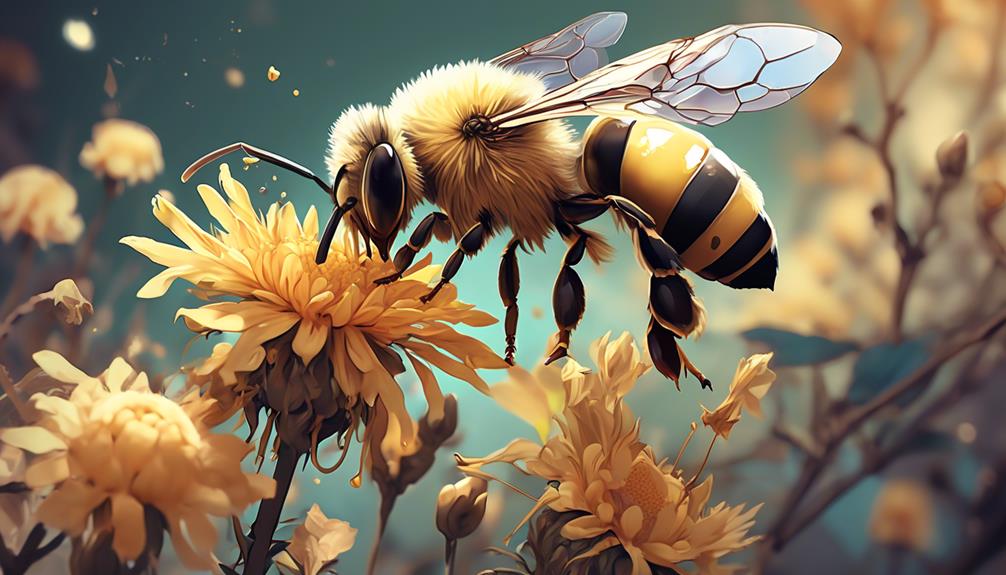
To fully comprehend how long bees can survive without food, you'll first need to delve into the fascinating intricacies of bee biology. Bees, like all insects, are ectotherms. They rely on external heat sources to regulate their body temperature. This characteristic is vital in understanding their dietary needs. Without the energy obtained from food, namely nectar and pollen, bees can't maintain their body temperature and eventually succumb to the cold.
Bees are also eusocial insects, meaning they live in highly organized colonies, each with specific roles. Worker bees, the ones you'll often see buzzing from flower to flower, have a lifespan of around 6 weeks during the active season. Their lives are spent tirelessly gathering food for the colony.
The queen, on the other hand, can live for several years, laying up to 2000 eggs per day. She's fed by the workers and rarely leaves the hive. This eusocial structure is critical in understanding a bee's survival without food. If food becomes scarce, worker bees prioritize feeding the queen and the larvae, even if it means their own demise.
Nutritional Requirements of Bees
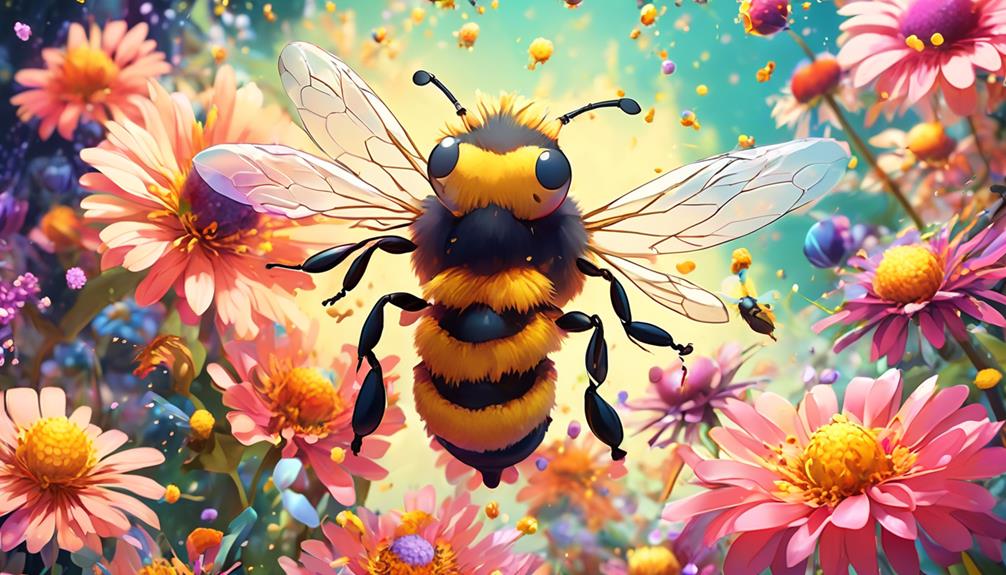
Understanding the nutritional needs of bees is crucial as they require a balanced diet of proteins, carbohydrates, lipids, vitamins, and minerals to thrive and perform their duties within the colony. Proteins are essential for growth and development, particularly in bee larvae. They acquire these nutrients primarily from pollen, with different pollen types providing varying protein content.
Carbohydrates, obtained from nectar and honeydew, fuel bees' energy-intensive flight and maintain body temperature. Lipids, though required in lesser amounts, contribute to energy storage, cell membrane structure, and hormone production. Bees derive lipids from pollen, plant oils, and nectar.
Vitamins and minerals, while needed in trace amounts, are vital for various metabolic processes. Bees get these micronutrients from nectar, pollen, and water. For instance, they need calcium for nerve function and magnesium for enzyme activity.
Understanding the nutritional requirements helps in managing bee colonies, especially during times of food scarcity. When necessary, you can supplement their diet to ensure their survival and productivity. However, remember that over-reliance on artificial feeds can diminish bee health and colony resilience. Balanced nutrition, acquired naturally, is still the best for bees.
How Bees Store Food
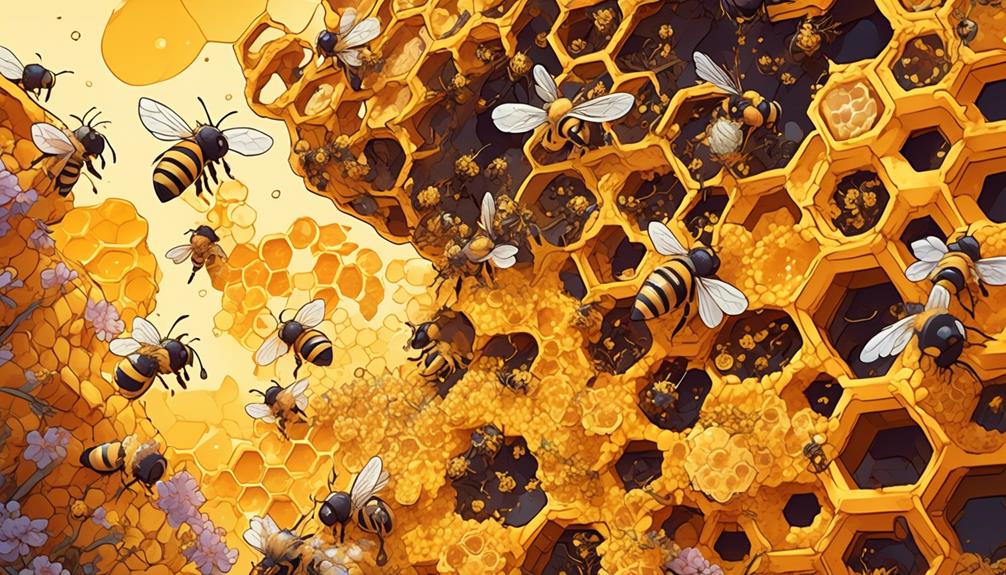
While ensuring their nutritional needs are met, bees also undertake the vital task of storing food for future consumption, a process you'll find fascinating in its efficiency and organization. Bees, particularly the hardworking honeybees, are experts at this, storing nectar and pollen in a way that's not only orderly but also ensures longevity.
Here's how it works: bees collect nectar, which is basically a sugar-rich liquid from flowers, and store it in their honey stomach. Back at the hive, it's transferred to worker bees who chew it, breaking down the complex sugars into simpler ones. This chewed nectar is then stored in the honeycomb cells.
Simultaneously, bees also collect pollen, a crucial protein source. They pack it into 'pollen baskets' on their hind legs. At the hive, it's stored in the honeycomb cells beside the nectar. The bees add a bit of honey or nectar and their own enzymes to this pollen, creating 'bee bread', another vital food source.
Both nectar and pollen undergo a drying process where bees fan their wings to evaporate water. This prevents fermentation and aids long-term storage. Once sufficiently dried, the cells are capped with beeswax, ensuring a well-stocked larder for the bees.
Factors Affecting Bees' Survival
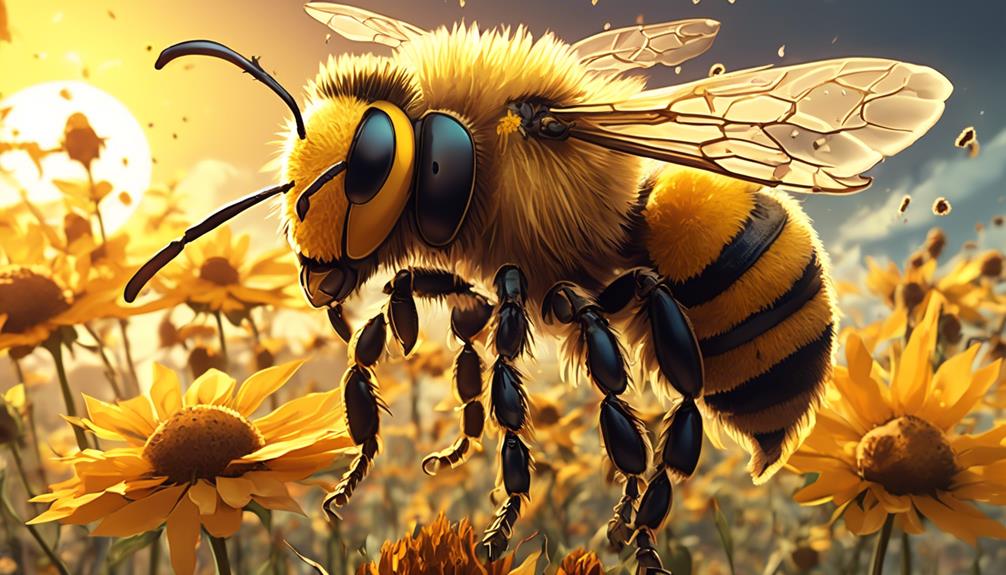
Numerous factors play a crucial role in the survival of bees, including their access to food, climatic conditions, and the presence of diseases and pesticides. You need to understand how these factors impact bees' longevity and survival in order to make informed decisions regarding their conservation.
Bees rely on nectar and pollen for nutrition. Any disruption in their food supply chain, whether due to seasonal changes or human activities, can drastically affect their survival rates. Likewise, climatic conditions can either favor or hinder the survival of bees. Extreme temperatures, high humidity, and rainfall can all have detrimental effects.
Diseases and pesticides, however, are the most threatening factors. Pathogens, parasites, and harmful pesticides can wipe out entire colonies if not managed properly.
Here's a simple table illustrating these factors:
Factor | Description | Impact on Bees |
|---|---|---|
Food Accessibility | Availability of nectar and pollen | Directly affects nutrition and reproduction |
Climatic Conditions | Temperature, humidity, rainfall | Can cause stress and affect food availability |
Diseases | Presence of pathogens and parasites | Can cause death and colony collapse |
Pesticides | Exposure to harmful chemicals | Can cause death and colony collapse |
Understanding these factors will help you contribute to the conservation of these essential pollinators.
Starvation Period for Different Bees
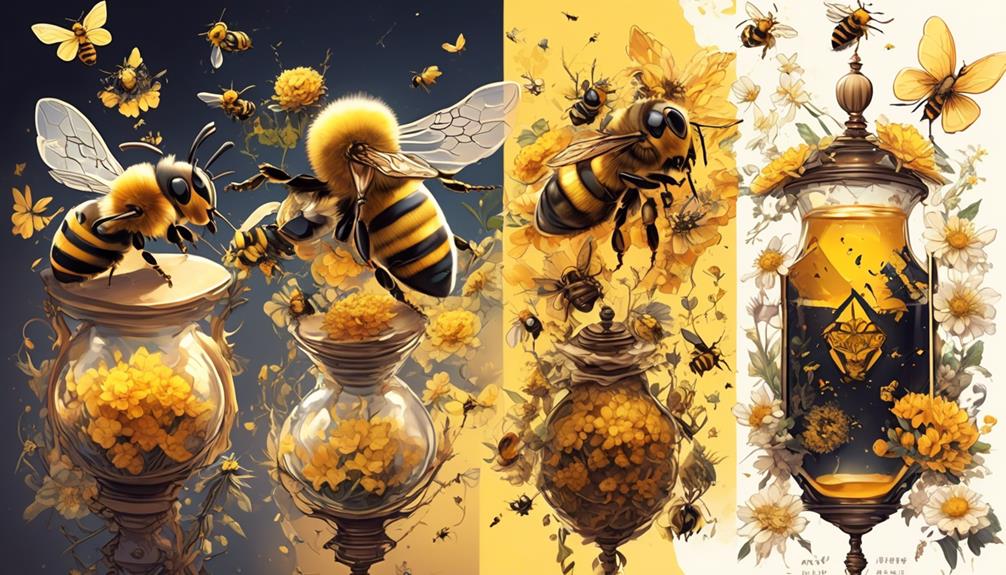
Given these factors, it's significant to note how long different types of bees can endure without food before starvation sets in.
Honeybees, for instance, can survive up to a week without any sustenance, due to their ability to store nectar in their honey stomachs.
Bumblebees, on the other hand, are more susceptible to starvation; they can only last for a few hours without food.
Worker bees, which make up the majority of a hive's population, are in a constant state of food collection and can starve quickly if deprived of sustenance.
Queen bees, however, can endure longer periods without food due to the nutritious royal jelly diet they receive during the larval stage.
Solitary bees, like mason and leafcutter bees, have a slightly longer survival timeframe. Their solitary nature enables them to store food in their nests, allowing survival for a few days without foraging.
Impact of Food Scarcity on Bees
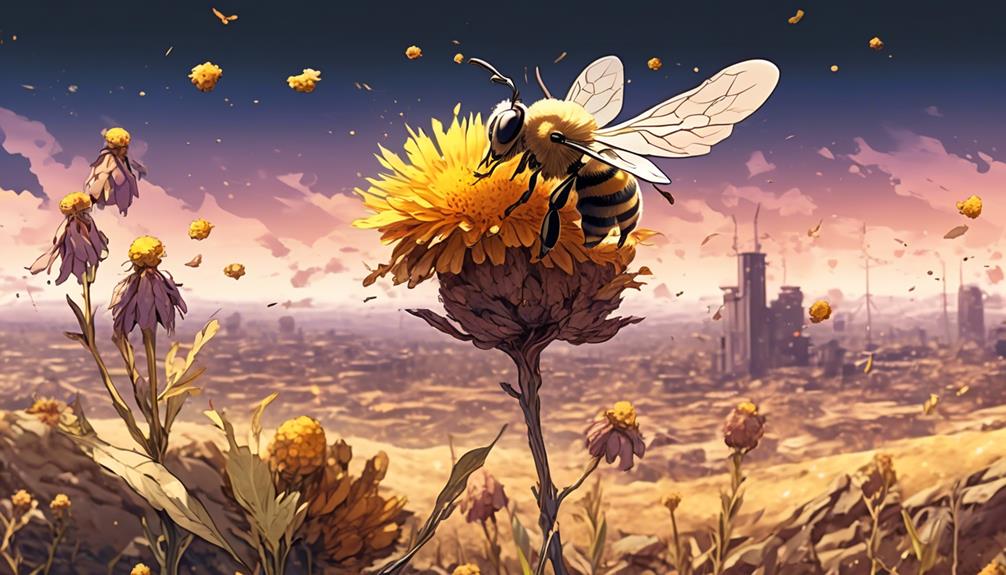
Food scarcity strikes a devastating blow to bee populations, significantly affecting their survival rate, reproduction, and overall hive health. When the food supply dwindles, bees can't function at their optimal level. Starvation becomes a harsh reality, and the hive's productivity takes a nosedive.
Consider this:
Impact | Description |
|---|---|
Survival Rate | Bees require substantial sustenance to survive. Without adequate nutrition, their resistance to disease plummets, and mortality rates soar. |
Reproduction | Food scarcity also impacts reproduction. When a colony is starved, it can't produce a healthy brood, leading to a dwindling bee population. |
Hive Health | The overall health of a hive is contingent on nourishment. A food-deprived colony is more susceptible to diseases and parasites, threatening the hive's stability. |
You see, bees aren't just important for honey production; they're critical for pollination. When their population declines, it doesn't only threaten their species but also the biodiversity of our ecosystem. So next time you see a bee, remember: they're not just buzzing around aimlessly. They're searching for the sustenance they need to keep our world alive. Their survival isn't just their concern, it's ours too.
Frequently Asked Questions
How Do Bees Communicate About Food Sources?
Bees use a unique communication method called the 'waggle dance.' When a worker bee finds a good food source, it returns to the hive and performs this dance to indicate the direction and distance of the food source.
The bee's movement pattern, combined with the time it takes to complete the dance, provides other bees with the necessary information to locate the food.
It's a fascinating example of non-verbal communication in the animal kingdom.
What Other Factors, Apart From Food, Contribute to a Bee's Lifespan?
Apart from food, various factors impact a bee's lifespan. You've to consider their species, as some live longer than others.
Environmental conditions are crucial too. If it's too hot or cold, bees can't survive long.
Pesticides also play a huge role in their life expectancy. They're highly toxic to bees and often lead to their death.
Lastly, the presence of predators and parasites can significantly shorten a bee's life.
Can Bees Adapt to Different Types of Food if Their Primary Food Source Is Unavailable?
Yes, bees can adapt to different food types when their primary source isn't available. They're naturally flexible eaters.
For instance, if nectar, their main food source, is scarce, bees can switch to eating other sweet plant secretions or honeydew produced by insects.
They're also known to consume pollen from various plant species.
However, this adaptability may not ensure optimal health or longevity, as certain food sources are nutritionally superior for bees.
How Does Climate Change Affect the Availability of Food for Bees?
Climate change impacts bees' food availability significantly. With warmer temperatures, flowering plants may bloom earlier or for shorter periods. If you're a bee, this means your food source isn't as reliable or abundant.
Additionally, extreme weather events can wipe out flowers, leaving you without food. So, climate change doesn't just make it hotter for you as a bee, it also threatens your dinner plate.
Are There Specific Bees Species That Are More Resilient to Food Scarcity Than Others?
Yes, there are specific bee species more resilient to food scarcity. For instance, honeybees can survive longer without food due to their stored honey.
Bumblebees are also quite hardy, with queens able to survive without food by entering a hibernation-like state.
However, solitary bees aren't as resilient, with many species unable to survive a single day without food.
Conclusion
So, how long can bees survive without food?
It depends on several factors like the bee species, time of year, and available food storage. Generally, bees can last a few days to weeks without food. However, prolonged food scarcity can severely impact their health and lifespan.
Your understanding of bee biology and their nutritional needs plays a vital role in ensuring their survival. Remember, bees are essential for pollination, so their wellbeing affects our ecosystem significantly.

